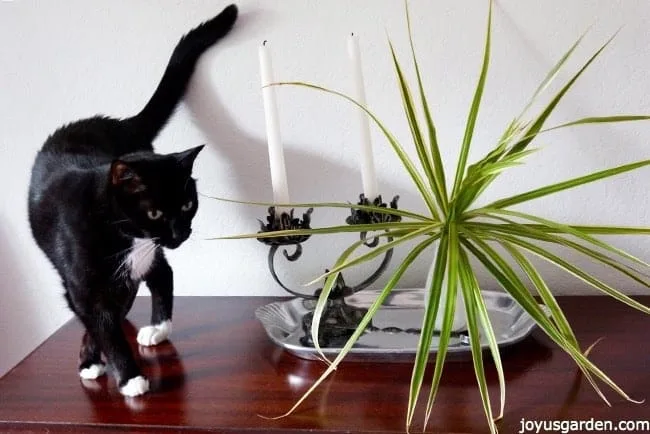Arrowhead Plant Propagation: A Syngonium Propagating Guide
Syngoniums are fast growers that can quickly become leggy. Pruning helps them stay lush and gives you a great opportunity to propagate new plants to add to your plant collection. Arrowhead Plant propagation is a breeze with stem cuttings. Let me show you two easy methods to get the job done.
Arrowhead Plants grow quickly, becoming dense over time, and eventually need a good pruning. Their thick, soft stems can get weighed down with foliage as they age, so I like to trim them regularly to keep the plant in check and prevent flopping.
Since Arrowhead Plants are vines in nature, regular pruning—about two times a year—helps keep them more compact and fuller on top. And while you’re at it, why not propagate a few of those cuttings?
Arrowhead Plant Propagation Guide
Botanical Name: Syngonium podophyllum Common Name: Arrowhead Plant, Arrowhead Vine, Arrowhead Philodendron
Arrowhead Plants (so named because of the arrow-shaped leaves) come in an array of leaf variegations, colors, and shapes. These propagation methods apply to all different varieties.
I’m outlining soil and water propagation here. I like the latter method because I can easily see the new roots emerging. Propagating by dividing the plant is also an option.

When is a good time to propagate an Arrowhead Plant?
The best time to propagate is during the growing season. Spring, summer, and fall are good times to propagate because warmer weather encourages faster root growth.
I did this propagation at the end of April. I’ve propagated in winter by stem cuttings, but it takes longer.
Tools You’ll Need
A pruning tool. I use my Felco 2 pruners or my Fiskar micro-tip pruners.
Jar or vase for water propagation.
Small pot with drainage holes for propagating in soil.
Light soil mix for soil propagation.

How to Propagate an Arrowhead Plant
Make sure your pruners are clean & sharp before taking the cuttings. You want to make clean cuts straight across.
A leaf node is where the roots emerge from. You can see what they look like in the photo below.
Take the cuttings at the desired length just below a leaf node. Make sure the stems are long enough so at least two or three nodes can be in the water or mix.
Remove some lower leaves from each healthy stem. They’ll likely die anyway, and new growth will emerge throughout the rooting process.
Place the cuttings in water or a mix. Make sure 2-3 nodes are covered by water or the mix. I use filtered room temperature water for water propagation.
How long should the cuttings be? The cuttings I took were 8 – 18″ from the bottom of the stems to the top of the tallest leaf. You can make them shorter or longer – whatever your preference is. Please don’t make them too long because they’ll get floppy quickly!
What mix to use for propagating: I rooted two of the cuttings in a grow pot in succulent & cactus mix. The roots of an Arrowhead Plant are very strong so you could use potting soil with a bit of pumice or perlite added in. It’s best to have drainage holes on the bottom of the pot so the excess water can readily flow out.
You can also propagate an Arrowhead Plant by division. Just know that as the plant ages, it gets thick and slightly twisted, so dividing one can be tricky.
Here’s a post on Arrowhead Plant Care that will be helpful if you’re new to growing this popular houseplant.

How fast does an Arrowhead Plant propagate?
The rooting process happens very quickly. I saw roots starting to emerge after six or seven days. Two weeks after the cuttings were put in water, roots had formed on both stems.
When I gently pulled on the cuttings in the succulent mix, I felt some resistance, so they were also on their way to rooting.
Where to put the cuttings while they’re rooting
The best place for your cuttings is a location with bright light but no direct sunlight. I put mine on the window sill in the guest bedroom, which has a north exposure. Lots of light comes in, but no sun hits them.

How to maintain the Arrowhead Plant cuttings
In water: I changed the water in the jar every 5-7 days to freshen and maintain the level, which also prevents bacterial growth. I used room temperature filtered water.
You can put them in potting soil once they’re rooted to your satisfaction.
In soil: The cuttings in the mix were watered every 4-5 days. You want moist soil to the touch but not sopping wet.
When the cuttings are ready for planting
You don’t have to wait too long. Because the roots are so strong, I could have planted these cuttings after three or four weeks, but I decided to wait another week or so to plant them.
I like to propagate the cuttings in water because it’s a snap, and I can see the rooting progress. Using a clear glass container also helps!


Planting the cuttings once they’re rooted
Once the cuttings in water are rooted, you can plant them into a proportionately sized pot.
My cuttings were on the smaller side, so I put them into a 4″ grow pot because a 6″ pot would be out of scale.
This tropical plant grows along the ground and up other plants in its natural environment. Its roots (aerial roots) are very strong and extensive, so you’ll need to repot them into a bigger pot at some point.
I’ve created a post and video on Repotting Arrowhead Plants, which you’ll find helpful. It includes the soil mix I like to use for these beautiful plants.
Arrowhead Plant propagation FAQs
These plants grow fast, and their stems become leggy and floppy over time. The best way to keep yours bushy is by pruning. Also, make sure your plant is growing in bright indirect light. Light levels that are too low can lead to a thin plant. I’ve received so many questions on this that I wrote a post on how to keep an Arrowhead Plant Bushy.
They propagate very easily in water. I’m not sure about growing one in water long term, but the longest period I’ve grown one in water is eleven months.
I included this question in case you didn’t read this entire post. The easiest way to propagate stem cuttings is in water and soil mix. Division is another option, but adult plants grow so full and crazy that you may have a hard time dividing them without losing some of the stems. Seed is another option, but I’ve read that the seedlings may not be true to the mother plant.
Arrowhead Plant Propagation Video Guide
Now that you’ve seen how easy and fast the propagation process is, you’ll have a thriving collection of Arrowhead Plants—and maybe even a few to gift!
Happy gardening,








Hi thanks for the propagating tip re syngoniums . I will surely try it out next week . I’m from Malta.
I am trying to propogate birds nest fern from spores. Any advice pls
Noel – You’re welcome. The syngoniums are a snap to propagate. I can’t give you any advice regarding the ferns as I’ve never propagated them from spores, only division. Nell
Wonderful post and video! I have a syngonium that I’m going to attempt to propagate for the first time, and your video has given me more confidence 🙂
Thank you for this step by step demonstration as well as information on how to care for the cuttings! Wonderful to see the one and a half week progress as well!
Thank you, Cindy! They root fast & they grow fast. It’s very easy to propagate them. Nell